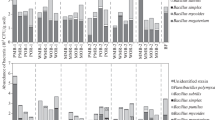Summary
The biomass of microbial-feeding nematodes and protozoa was measured in the rhizospheres of peas, barley, grass and turnips grown for 10 weeks in pots containing a clay-loam soil; in the rhizospheres of peas and barley grown for 3 weeks in a sandy soil; and in the rhizosphere of barley grown for 11 weeks in an unfertilised and a fertilised clay-loam soil. The nematode biomass was consistently larger in the rhizosphere of all plants in both soils than in the bulk soil, but the protozoa biomass showed a rhizosphere effect only under pea and fertilised barley. The biomass of nematodes in the rhizosphere (1.2–22.3 μg dry weight g-1 dry soil) was greater than the biomass of protozoa (0.1–3.2 μg g-1), and greater under pea>barley>grass>turnip. It is suggested that nematodes are more able to exploit low bacterial densities than protozoa and that they initially migrate into the rhizosphere from the bulk soil. In samples of potato rhizosphere from field-grown plants, the nematode biomass was also greater than the active and total protozoan biomass. It is argued that in the rhizosphere the biomass of microbially feeding nematodes exceeds that of protozoa and that nematodes are more important in terms of nutrient cycling.
Similar content being viewed by others
References
anderson RV, Gould WD, Woods LE, Cambardella RE, Ingham RE, Coleman DC (1983) Organic and inorganic nitrogenous losses by microbivorous nematodes in soil. Oikos 40:75–80
Bamforth SS (1985) The role of protozoa in litters and soils. J Protozool 32:404–409
Boag B (1974) Nematodes associated with forest and woodland trees in Scotland. Ann Appl Biol 77:41–50
Clarholm M (1981) Protozoan grazing of bacteria in soil-impact and importance. Microb Ecol 7:343–350
Clarholm M (1985) Possible roles for roots, bacteria, protozoa and fungi in supplying nitrogen to plants. In: Fitter AH (ed) Ecological interactions in soil. Special publication no. 4, British Ecological Society, Blackwell Oxford, pp 255–265
Darbyshire JF, Greaves MP (1967) Protozoa and bacteria in the rhizosphere of Sinapis alba L., Trifolium repens L. and Lolium perenne L. Can J Microbiol 13:1057–1068
Darbyshire JF, Wheatley RE, Greaves MP, Inkson RHE (1974) A rapid micromethod for estimating bacterial and protozoan populations in soil. Rev Ecol Biol Sol 11:465–475
Freckman DW (1982) Parameters of the nematode contribution to ecosystems. In: Freckman DW (ed) Nematodes in soil ecosystems. Universtiy of Texas Press, Austin, pp 81–97
Goodey JB (1963) Soil and freshwater nematodes. 2nd, Methuen, London, John Wiley, New York
Griffiths BS (1986) Mineralization of nitrogen and phosphorus by mixed cultures of the ciliate protozoan Colpoda steinii, the nematode Rhabditis sp. and the bacterium Pseudomonas fluorescens. Soil Biol Biochem 18:637–641
Griffiths BS, Ritz K (1988) A technique to extract, enumerate and measure protozoa from mineral soils. Soil Biol Biochem 20:163–173
Henderson VE, Katznelson H (1961) The effect of plant roots on the nematode population of the soil. Can J Microbiol 7:163–167
Hunt HW, Cole CV, Klein DA, Coleman DC (1977) A simulation model for the effect of predation on bacteria in continuous culture. Microbiol Ecol 3:259–278
Hunt HW, Coleman DC, Ingham ER, Ingham RE, Elliott ET, Moore JC, Rose SL, Reid CPP, Morley CR (1987) The detrital food web in a shortgrass prairie. Biol Fertil Soils 3:57–68
Hurley MA, Roscoe ME (1983) Automated statistical analysis of microbial enumeration by dilution series. J Appl Bacteriol 55:159–164
Ingham RE, Trofymow JA, Ingham ER, Coleman DC (1985) Interactions of bacteria, fungi and their nematode grazers: Effects on nutrient cycling and plant growth. Ecol Monogr 55:119–140
Ingham ER, Trofymow JA, Ames RN, Hunt HW, Morley CR, Moore JC, Coleman DC (1986) Trophic interactions and nitrogen cycling in a semi-arid grassland soil. I. Seasonal dynamics of the natural populations, their interactions and effects on nitrogen cycling. J Appl Ecol 23:597–614
Klemedtsson L, Berg P, Clarholm M, Schnürer J, Rosswall T (1987) Microbial nitrogen transformations in the root environment of barley. Soil Biol Biochem 19:551–558
Laing D (1976) The soils of the country round Perth, Arbroath and Dundee. Memoir of the soil survery of Great Britain, HMSO, Edinburgh
Page FC (1967) Taxonomic criteria for Limax amoebae with descriptions of 3 new species of Hartmanella and 3 of Vahkampfia. J Protozool 14:499–521
Pharmacia. Percoll methodology and applications. Pharmacia, S-751 82 Uppsala, Sweden
Schnürer J, Clarholm M, Boström S, Rosswall T (1986) Effects of moisture on soil microorganisms and nematodes: A field experiment. Microb Ecol 12:217–230
Singh BN (1946) A method for estimating the numbers of soil protozoa, especially amoebae, based on their differential feeding on bacteria. Ann Appl Biol 33:112–119
Singh BN (1964) Soil protozoa and their probable role in soil fertility. Bull Natl Inst Sci India 26:238–244
Smith GS, Johnston CM, Cornforth IS (1983) Comparison of nutrient solutions for the growth of plants in sand culture. New Phytol 94:537–548
Sohlenius B (1968a) Influence of microorganisms and temperature upon some Rhabditid nematodes. Pedobiologia 8:137–145
Sohlenius B (1968b) Studies of the interactions between Mesodiplogaster sp. and other rhabditid nematodes and a protozoan. Pedobiologia 8:340–344
Stout JD, Heal OW (1967) Protozoa. In: Burgess A, Raw F (eds) Soil biology. Academic Press, London, pp 149–195
Taylor WD (1978) Growth responses of ciliate protozoa to the abundance of their bacterial prey. Microb Ecol 4:207–214
Wood FH (1973) Feeding relationships of soil-dwelling nematodes. Soil Biol Biochem 5:593–601
Woombs M, Laybourn-Parray J (1984) Feeding biology of Diplogasteritus nudicapitatus and Rhabditis curvicaudata (Nematoda) related to food concentration and temperature, in sewage treatment plants. Oecologia (Berlin) 64:163–167
Yeates CW (1979) Soil nematodes in terrestrial ecosystems. J Nematol 11:213–229
Author information
Authors and Affiliations
Rights and permissions
About this article
Cite this article
Griffiths, B.S. A comparison of microbial-feeding nematodes and protozoa in the rhizosphere of different plants. Biol Fertil Soils 9, 83–88 (1990). https://doi.org/10.1007/BF00335867
Received:
Issue Date:
DOI: https://doi.org/10.1007/BF00335867




